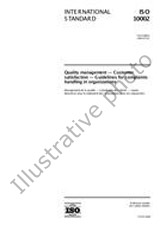We need your consent to use the individual data so that you can see information about your interests, among other things. Click "OK" to give your consent.

ISO/IEC 10179-ed.1.0
Information technology - Processing languages - Document Style Semantics and Specification Language (DSSSL)
Translate name
STANDARD published on 4.4.1996
The information about the standard:
Designation standards: ISO/IEC 10179-ed.1.0
Publication date standards: 4.4.1996
SKU: NS-940622
The number of pages: 292
Approximate weight : 907 g (2.00 lbs)
Country: International technical standard
Category: Technical standards ISO
The category - similar standards:
IT applications in information, documentation and publishing
Annotation of standard text ISO/IEC 10179-ed.1.0 :
This International Standard is designed to specify the processing of valid SGML documents. DSSSL defines the semantics, syntax, and processing model of two languages for the specification of document processing: a) The transformation language for transforming SGML documents marked up in accordance with one or more DTDs into other SGML documents marked up in accordance with other DTDs. The specification of this transformation process is fully defined by this International Standard. b) The style language, where the result is achieved by applying a set of formatting characteristics to portions of the data, and the specification is, therefore, as precise as the application requires, leaving some formatting decisions, such as line-end and column-end decisions, to the composition and layout process. The DSSSL style language is intended to be used in a wide variety of environments with typographic requirements ranging from simple single-column layouts to complex multiplecolumn layouts. This International Standard does not standardize a formatter nor does it standardize composition or other processing algorithms. Rather, it provides the means whereby an implementation may externalize style characteristics and other techniques for associating style information with an SGML document. DSSSL provides a mechanism for specifying the use of external processes to manipulate data. The nature of these processes is outside the scope of DSSSL, but may include typical data management functions, such as sorting and indexing; typical composition functions, such as hyphenation algorithms; and graphics or multimedia processes for non-SGML data. Documents that have already been formatted or do not contain any hierarchical structural information or generic markup are not within the field of application of this International Standard. DSSSL expresses specifications to be performed by some processor that accepts an input document and produces an output document. DSSSL is independent of the type of formatter, formatting system, or other transformation processor. a) Constructs that provide access to, and control of, all possible marked-up information in an SGML document, as well as mechanisms for string processing to allow for the manipulation of non-marked up data. This is provided by the Standard Document Query Language (SDQL) component of DSSSL. NOTE I String processing is necessary so that no special markers need be embedded in the source document to indicate presentational changes. The display of a dropped or raised capital letter in a larger point size at the beginning of a line or paragraph is an example of a case where string processing may be used to isolate the first character or group of characters in order to achieve a desired presentational effect. b) Provisions for specifying the relationship between one or more SGML documents as input to a transformation process and zero or more resulting SGML documents as the output of the process. c) Provisions for specifying the relationships between the SGML document(s), as expressed in the source Document Type Definition(s), and the result of the formatting process. The output of the formatting process may be an 1SO/IEC l 0 180 Standard Page Description Language (SPDL) document or it may be a document in some other, possibly proprietary, form. d) Provisions for describing the typographic style and layout of a document. e) Definitions of a machine-processable syntax for the representation of a DSSSL specification and its various components. f) Provisions for creating new DSSSL characteristics and their associated values, as well as new flow object classes. These are declared in the declarations for the style language portion of the DSSSL specification. This International Standard is intended for use in a wide variety of SGML application environments, including both electronic publishing and conventional printing.
These changes apply to this standard:
Information technology - Processing languages - Document Style Semantics and Specification Language (DSSSL) - Amendment 1: Extensions to DSSSL
Change published on 9.10.2003
Selected format:Show all technical information.
Information technology - Processing languages - Document Style Semantics and Specification Language (DSSSL) - Amendment 2: Extensions to multilingual and complicated document styles
Change published on 3.8.2005
Selected format:Show all technical information.
These corrections apply to this standard:
Information technology - Processing languages - Document Style Semantics and Specification Language (DSSSL) - Technical Corrigendum 1
Correction published on 15.3.2001
Selected format:Show all technical information.
We recommend:
Updating of laws
Do you want to be sure about the validity of used regulations?
We offer you a solution so that you could use valid and updated legislative regulations.
Would you like to get more information? Look at this page.



 Cookies
Cookies
